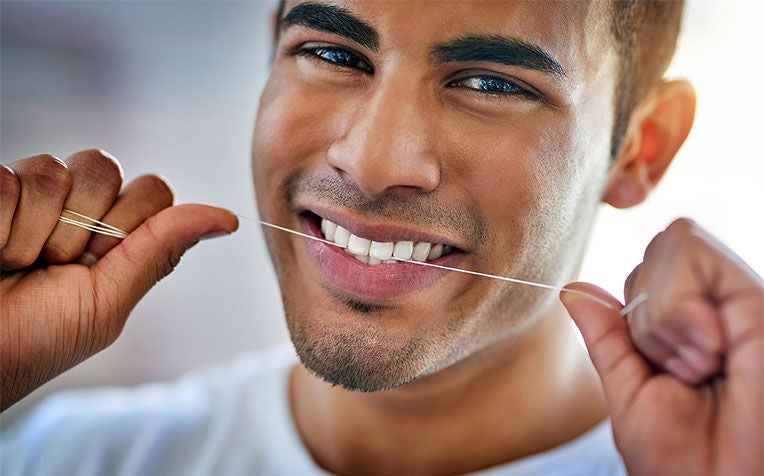
Flossing daily, preferably before bedtime, can help to prevent the plaque buildup.
"About
only three in every 10 people floss regularly at night," shares Ms Kimberly Chim, Oral Health Therapist from
National Dental Centre Singapore (NDCS), a member of the
SingHealth group.
"Here, people are always in a rush. They tend to brush their teeth for only a minute instead of the required three minutes. Flossing, which needs manual dexterity, may prove too troublesome," she adds.
But flossing is vital to good dental health, and here's how to do it right.
How to floss correctly
How to floss your front teeth
1. Cut an arm's length of floss and coil it around each middle finger.
2. Adjust the “active” length to between 4cm and 5cm for front teeth, and 10cm for back ones.
3. Using both hands, hold the floss with the thumbs and index fingers, and gently slide the floss between two teeth. Move it gently down in a sawing motion. Be careful not to push the floss aggressively down on the gum as it will hurt or traumatise the gum. Once between the teeth, curve the floss around the tooth and gently floss the sides of each tooth. This includes using the floss to scoop under the gum line, where bacteria can reside.
How to floss your back teeth
4. Use a similar flossing technique for back teeth. Lengthen the floss, secure both ends with the middle fingers before using the index fingers to push the middle portion of the floss upwards to form a U-shaped curve. This is to help one manoeuvre it better. Repeat the earlier steps of sliding the floss between teeth and gently scooping under the gum line.
5. Do one gap at a time, and use a fresh section of floss for each gap. When flossing is done properly and gums are healthy, there should be no bleeding.

Types of floss: How to pick the one that is right for you
1. Tufted dental floss
Good for cleaning braces, bridges and dental implants, it has three sections: a stiffened portion to guide it into gaps or under dental appliances; a fluffy, spongy section, which looks thick but easily contracts and expands to clean around appliances and in wide spaces; and regular floss to remove plaque under the gum line.
2. Regular floss
It is not as thick as tufted dental floss. It is available waxed and unwaxed, with waxed being more popular as it is easier to use. Waxed floss does not splay or split easily when going over rough edges, compared to unwaxed ones. Dentists tend to use waxed floss in their clinics.
3. Flavoured floss
Gimmicky – they come in strawberry, mint and other flavours, offering a pleasant experience rather than anything medically significant.
4. Whitening floss
Whitening floss does not bleach teeth but gives the illusion of whitening because it is coated with microscopic abrasives that will effectively remove particles between teeth for a cleaner and brighter look. It works differently from professional whitening, and does not work any better than regular floss.
5. Floss holder
It is an F- or Y-shaped holder for a piece of floss. Meant for beginners, young children and those with limited finger dexterity, it is not recommended for those with misaligned teeth. Although different in form from regular floss, the flossing technique remains the same. There may be a toothpick at one end, but exercise caution, as clumsy use of toothpicks can hurt gums.
Why flossing is essential
But flossing, especially
before bedtime, is vital. "We encourage
flossing, particularly at night, to remove food debris from the day. This is because at night, saliva secretion slows down. Saliva has good bacteria that can combat bad bacteria in the mouth. Its protective function helps rebalance the PH level in the mouth, to control bacteria which damages gums and teeth."
She said brushing cleans only 60 per cent of teeth, but it does not remove bacteria and food debris from tight spots and gum pockets. Floss gets to the parts where toothbrush bristles cannot go – in-between teeth – for a thorough clean.
Plaque (dental bacteria) causes gum inflammation. If left untreated, it can lead to severe gum disease called periodontitis, where gum tissue weakens and teeth loosen with the loss of the supporting bone structure.
"It is very important to prevent these problems by visiting a dentist or oral health therapist at least once a year. We can also advise on the kind of floss, dental aids or brushes to use for your specific condition. We have had patients with
gum disease who made big improvements after diligent oral care."
New to flossing? How to start
To overcome the reluctance to floss, Ms Chim recommends starting small. "Ideally, it should take two to three minutes to do the entire mouth, but give yourself five to 10 minutes when you start.
"Floss your front teeth first, as they are easier to manipulate. Do one gap at a time. Once you get used to it, try another gap until you reach the back teeth. Before you know it, you've done your whole mouth!"
Ref: I23 (ed)
More oral health articles you may be interested in:
Root Canal Treatment: How Painful Is It?
















 Get it on Google Play
Get it on Google Play